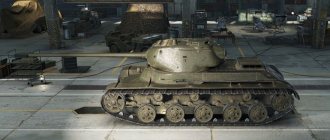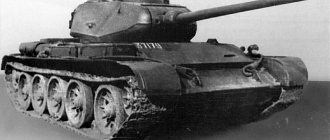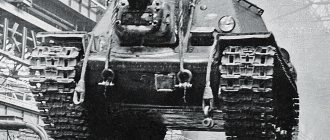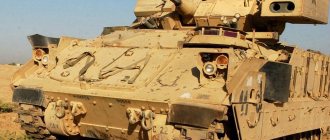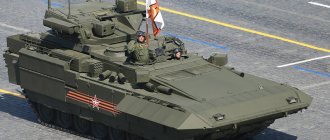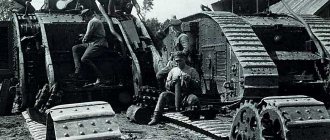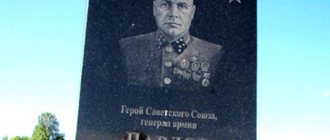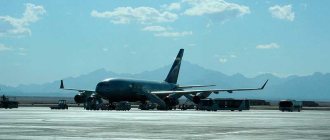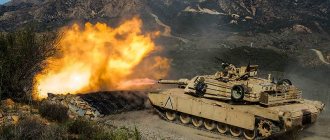History of creation
The Spanish War showed that all Soviet tanks needed significantly increased armor protection. This requirement especially applied to heavy tanks, so in 1938, the Kirov plant began to develop the SMK heavy tank, and at the Leningrad plant, in parallel, they began to develop the T-100. The work was carried out on a competitive basis - only one of the two tanks was to be accepted for service.
Until August 1938, tanks were only at the project stage. Finally, an order was received to produce a sample of the QMS by May 1, 1939. During the design and manufacturing process, it was decided to abandon one of the three towers, and work also began on a single-tower version - the future. In January 1939, the production of the tank in metal began.
SMK toured the plant for the first time on April 30th. On August 1st, comparative field tests began with the T-100 and KV. The SMK passed the tests, but it was noted that the vehicle was quite difficult to drive, and the commander did not cope well with fire control from two guns at once.
As a result, by December 1939, the SMK's mileage was 1,700 km. Serial production of the car never began.
Factory workers at the front
These tests began in July 1939 and lasted until November - during this time the SMK managed to travel 1,700 kilometers. In general, everything was going well for him. But then the opportunity arose to test the double-turret tank in combat conditions: the Winter War began.
It was decided to send the tank to the front, and then the crew’s question arose: who should be put inside - the military or the factory workers? On the one hand, the former are better prepared for war, but the latter know the design of a tank that has not yet gone into production.
As a result, the crew was combined. The commander, his assistant, gunner and gunner-radio operator are military. They were joined by plant specialists: a mechanic driver and a motor mechanic with a transmission operator.
QMS in testing (thearmoredpatrol.com)
QMS in testing (thearmoredpatrol.com)
Performance characteristics (TTX)
general information
- Classification – heavy tank;
- Combat weight - 55 tons;
- The layout is classic, double-tower;
- Crew – 7 people;
- Quantity issued – 1 piece.
Dimensions
- Case length – 8750 mm;
- Hull width – 3400;
- Height, mm 3250
- Ground clearance, mm 500
Booking
- Armor type - rolled homogeneous steel;
- Body forehead – 75 mm;
- Hull side – 60 mm;
- Hull stern – 55 mm;
- Bottom – 20-30 mm;
- Housing roof – 30 mm;
- Turret forehead – 60 mm;
- Gun mantlet – 60 mm;
- Turret side – 60 mm;
- Turret rear – 60 mm;
- Tower roof – 30 mm.
Armament
- The caliber and brand of the gun are 76 mm L-11 and 45 mm 20K;
- Gun type - tank;
- Barrel length - 30 calibers for L-11, 46 calibers for 20K;
- Gun ammunition is 113 and 300, respectively;
- BH angles: +35°/-7° (76 mm) and +25°/-7° (45 mm);
- GN angles: 360° (main tower) and 270° (small tower);
- Sights - telescopic TOP mod. 1930, periscope PT-1 mod. 1932
- Machine guns - 4 × 7.62 mm DT, 1 × 12.7 mm DShK.
Mobility
- Engine type - V-shaped 12-cylinder carburetor liquid cooling GAM-34;
- Engine power – 850 hp;
- Highway speed – 34.5 km/h;
- Speed over rough terrain – 15 km/h;
- Cruising range on the highway – 280 km;
- Cruising range over rough terrain – 230 km;
- Suspension type – torsion bar;
- Specific ground pressure - 0.662 kg/cm²;
- Climbability – 37 degrees;
- The wall to be overcome is 1.1 m;
- The ditch to be overcome is 4 m;
- The fordability is 1.7 m.
From Kharkov to Leningrad
Joseph Kotin's design talent first appeared in the 1920s, when as a teenager he got a job at a Kharkov boiler-mechanical plant. Here the future designer came up with an improvement for the metalworking machine and even received a patent for the invention.
Having graduated from the workers' school in parallel with his work, Kotin, at the insistence of his parents, went to study to become a doctor. But the craving for technology overpowers, and he is transferred to the automotive department of the Kharkov Institute of Technology. From there, in 1929, for his excellent studies, he was sent to the Leningrad Military Technical Academy at the Faculty of Mechanization and Motorization of the Red Army. Marshal M.N. himself attended the defense of Kotin’s diploma project. Tukhachevsky, then in charge of the rearmament of the army. Until 1937, military engineer 3rd rank Joseph Kotin worked at the academy, where he studied tank research, studied the issues of landing heavy equipment and rose to the rank of head of the research department.
At the age of 29, Kotin is already the head of the SKB-2 tank design bureau at the country's largest machine-building plant, the Kirov Plant in Leningrad. Kotin's energetic solution to organizational issues accelerated the work of the team. Since 1938, SKB-2 has been developing the heavy three-turret breakthrough tank SMK (“Sergei Mironovich Kirov”). Later, a single-turret tank with reinforced KV anti-ballistic armor (Klim Voroshilov) was added to it. Such names were not given to tanks by chance - the name itself increased the responsibility of the development.
Application of QMS in combat
On November 30, 1939, the Soviet-Finnish war began. It was decided to deliver newly developed heavy tanks to the combat area, so the SMK, KV and T-100 went there. There were no specialists in the troops capable of operating these machines, so volunteer factory testers were included in the crews.
The tanks were planned to be used to push through enemy defenses and break through passages in the wire fence. SMK led a column of experimental vehicles, managed to break through the fence, overcome the ditch and approach the granite ridges. The Finns failed to break through the car.
The next day the attack was repeated two more times - and both times all the experienced vehicles returned undamaged. After the order to support the units that had broken through in the Sumy area, the tanks formed a column, which was also headed by the SMK. After one hit, the tank's turret became jammed, and on the road the vehicle ran over a pile of boxes and was damaged by the explosion. The T-100 and KV, together with the stationary SMK, formed a triangular fortress. They fired back, simultaneously trying to put the SMK on the move, but the damage was too serious, and the ice did not allow the T-100 to tow the damaged vehicle.
As a result, the SMK shot all the ammunition, and its crew moved to the T-100, which, together with the KV, returned to the 20th Tank Brigade.
At the end of December 1939, they tried to evacuate the damaged SMK, but nothing happened due to oncoming fire. After that, they tried to pull the tank out several more times, but the 55-ton vehicle was firmly stuck in the crater. For a long time, the SMK was used as a dugout, which provided good protection from bullets and withstood direct hits from enemy guns.
After the war, the tank was pulled out - for this it was necessary to use six T-28s. It was towed to Perk-Yarvi, dismantled and sent to the Kirov plant. At first, the tank was planned to be transferred to Kubinka after repairs, but the repairs were never carried out, and in the 1950s the SMK was sent for melting down.
Tank photos
SMK and T-100 tanks
SMK and T-100 tanks
In April 1938, to speed up the design of a new heavy breakthrough tank, the ABTU of the Red Army involved the Leningrad Kirov Plant and Plant No. 185 named after them in this work. S.M.Kirova. At the first, the SMK tank was created - “Sergei Mironovich Kirov” (leading engineer A. Ermolaev), at the second - the T-100 (leading engineer E. Paley).
Until August 1938, having no contracts for the production of new machines, the factories carried out mainly preliminary design. Work began in full swing only after the adoption of the resolution of the Defense Committee under the Council of People's Commissars of the USSR No. 198-ss dated August 7, 1938, which defined tactical and technical requirements and set strict deadlines for the production of new tank models: SMK - by May 1, T-100 - by June 1, 1939.
Creating a new tank to replace the T-35 was a rather difficult problem. The armament of three guns (2-45 mm and 1-76 mm) with anti-ballistic armor and a weight limit of up to 55 tons made it impossible to manufacture such a vehicle on the T-35 base, even if only three turrets were retained on it. Removing the machine gun turrets did not provide any noticeable weight savings to increase the thickness of the armor.
To meet the specified weight, it was necessary to reduce the geometric dimensions of the tank, moving to a new layout. The choice of solutions turned out to be small. It was possible, for example, to reduce the length of the hull by placing two turrets with 45 mm cannons side by side in front, and a large turret elevated above them. But, unfortunately, the width of the body was not enough for this. It was impossible to expand the hull, since by reducing the length of the tank, in order to prevent the specific pressure on the ground from increasing, the tracks would also have to be expanded, and the overall width of the vehicle was limited by the railway gauge. (The use of replaceable tracks, as on the Tiger, was not even considered by our designers.)
The Kirov Plant design bureau decided to use the layout as on the T-35 (with a diagonal arrangement of gun turrets), but try to make the layout more dense.
To do this, the small turrets were moved as much as possible to the sides of the tank, onto the fenders. The engine was also moved to the side and connected to the gearbox with a special transmission (guitar). In this case, the rear gun turret and its fighting compartment were located on the left side of the rear part of the hull, and the engine was located on the right. True, there was no room left at all for radiators of the engine cooling system, which in domestic tanks of that time were usually installed on the sides. Therefore, they and the blower were placed in front of the engine, and the air exhaust hole was made in the side of the hull, under the turret box of the main turret.
This arrangement made it possible to reduce the volume of the body and, accordingly, reduce weight. The suspension was supposed to be of the T-35 type or an experimental torsion bar, which was already being worked on at the Kirov plant.
The tank's turrets were designed to be conical. Moreover, the main one was very reminiscent of the main turret of the T-28, with machine gun installations located in a niche and near the commander’s seat. But despite all the measures taken, it was not possible to completely protect the entire tank with 60 mm armor. To fit into the required 55 tons, 50 mm armor had to be installed in some places.
Plant No. 185 went a different route. Having reasoned that if the width of the hull is not enough to install two small towers side by side, then the width of the tank allows this to be done. Therefore, they used the reverse layout of the T-28. The main turret was placed in the front part of the hull, and behind it, elevated on the turret box, were two 45-mm turrets. True, none of the towers had all-round fire, but in the wide forward sector, unlike the SMK, all three could fire.
Life-size wooden models and drawings of combat vehicles were considered by a special mock-up commission chaired by the assistant head of ABTU KA, military engineer 1st rank Korobkov, on October 10 and 11, 1938.
Three-turreted versions of the SMK tank: at the top - with a torsion bar suspension, at the bottom - with a balancing suspension similar to the T-35
Both projects made a mixed impression on the commission members. On the one hand, in terms of weight, armor, and weapons, all the requirements were met. But at what cost?
In the SMK, the fighting compartment of the rear small turret would be constantly heated by the nearby engine, and if the sealing was poor, its crew could also get burned. It’s the same with the T-100: the fighting compartment of the main turret would be heated by radiators.
It was also confusing that the 76-mm cannon had a limited field of fire, and the tank commander, located in the main turret, had a limited view. But at the same time, it became clear that the designers did everything possible within the proposed technical specifications, so the latter had to be changed, reducing the number of towers from three to two.
Later, with the light hand of Kotin, a legend was born about how at a meeting of the Defense Committee held in the Kremlin on December 9, 1938, Stalin impromptu removed one turret from the SMK model, and then from the T-100, and both tanks turned into two-tower. In fact, all the leader’s impromptu statements were almost always very well prepared and were based on advance consultations with recognized experts.
At the same meeting, representatives of the Kirov plant received permission to produce a single-turret version of the breakthrough tank, “similar in its characteristics to the SMK tank.” A little later it received the designation KV.
Naturally, simply removing one tower did not solve the problem, and both factories had to radically rework their designs, leaving little of the previous options.
In January 1939, the drawings of all tanks were transferred to production. For the May Day holidays Kirov SMK. The production of the T-100 and KV took about two months. On July 25, after running in and eliminating minor deficiencies, the SMK and T-100 were transferred to field testing.
The layout of the tanks differed from the classic one in that the weapons were placed in two diametrically elevated turrets. At the same time, both turrets of the T-100 were installed strictly along the longitudinal axis of the tank, while the small turret of the SMK was slightly shifted to the left. The large turrets on both tanks were mounted on high turret boxes. The placement of the crew members was also the same: in the control compartment along the axis of the vehicle there was a mechanic-driver, to the right of him was a radio operator (in QMS - a gunner-radio operator); in the small turret there is a gunner (turret commander) and loader, in the large turret there is a tank commander, gunner and loader. In addition, each car had space for a technician.
The large turret of the T-100 tank was equipped with a 76-mm L-10 cannon and a coaxial DT machine gun. The gun's pointing angles ranged from -5.5° to +26° in the vertical plane.
SMK tank undergoing field testing. August 1939. The shape of the tracks, the installation of the directional machine gun, the antenna input, the headlight and the sound signal are clearly visible.
On the roof of the main tower there was what is sometimes called a machine gun, and sometimes a commander's cupola. In fact, it was a closed anti-aircraft turret.
The tank commander on the T-100 sat in the same way as on the SMK and T-35, that is, to the right of the gun, and monitored the battlefield through a periscope. And the loader fired from an anti-aircraft machine gun, standing on his seat and using a special periscope sight. The machine gun occupied the entire space of the turret, and it was possible to stick your head in there only by lifting its barrel up 90°. In this position, it was possible to use the viewing slits cut along the perimeter of the turret after the tank was manufactured, since the field of view of the periscope sight was small and the shooter could lose orientation. Theoretically, it was possible to shoot from the turret at ground targets, albeit very distant ones, since the machine gun did not have a descent angle.
The armament of the large turret of the SMK tank was somewhat different. It was equipped with a 76-mm L-11 cannon. The gun and coaxial DT machine gun had vertical guidance angles from -2° to +33°. The anti-aircraft machine gun was placed openly on the turret hatch turret. Another diesel engine was mounted in the rear plate of the large SMK tower.
The armament of the small turrets of both tanks was identical - a 45-mm 20K cannon and a coaxial DT machine gun. The horizontal guidance angle of the 45-mm cannon of the T-100 tank was 256°, that of the SMK tank was 270°.
QMS
The SMK tank also had a DT machine gun in a ball mount. The radio operator fired from it. The turret rotation mechanisms were equipped with manual and electromechanical drives.
For firing and monitoring the battlefield, panoramic and telescopic sights PTK, PTKU, TOP, PT-1, TOD and TZP were used (the last two only on the T-100).
In the aft part of the hull of both tanks there was a 12-cylinder carburetor four-stroke V-shaped aviation (more precisely, marine glider) liquid-cooled engine GAM-34-VT with a power of 850 hp. at 1850 rpm. On the T-100, the engine was located along the axis of the vehicle, while on the SMK it was shifted to the starboard side (a legacy of the three-turret design).
The mechanical power transmission of SMK tanks consisted of a multi-disc main dry friction clutch, a five-speed gearbox, multi-disc dry friction side clutches with band brakes and two-stage final drives.
The transmission of the T-100 tank included a three-disc main dry friction clutch, a five-speed gearbox, multi-disc dry friction side clutches with band brakes and simple single-row final drives. Onboard clutches and brakes had pneumatic control servo drives and a backup mechanical drive.
The radiator of the cooling system with a capacity of 70 liters in the SMK tank was blown with air using a fan mounted on the toe of the crankshaft.
SMK tank undergoing field testing. Above is a view from the starboard side, below is a view from the rear. Note the 12.7 mm DK machine gun in the niche of the large turret.
The T-100 had two radiators with a total capacity of 100 liters. They were blown using a fan mounted horizontally on a stand on the gearbox.
In the design of the T-100 engine compartment, an attempt was made to protect the tank from a new anti-tank weapon that was widely used in Spain - petrol bombs. The roof of the MTO did not have openings for the intake and exhaust of cooling air and was inclined - so that the flammable mixture would drain faster from the body. Air intake and exhaust were carried out from the side, above the wings, through special armor pockets.
On the drawings this solution looked good, but tests of the tank and its combat use made their own adjustments. The very first rides of the T-100 chassis (still without turrets) showed that the engine was overheating greatly. The cooling air, passing through the armor pockets, already experienced great resistance at the inlet and outlet, and since the pockets were nearby, the cooling system sucked in hot air that was barely thrown out of the tank. I had to seal the air exhaust holes in the side of the hull and cut them in the wings. Now the exhaust air was released onto the upper branches of the tracks. This partially solved the cooling problem, and on the second chassis (the future T-100Y), the MTO was redesigned so that the exhaust of air down onto the tracks became standard, and at the same time the exhaust pipes were also brought out there.
During further testing of the T-100, new problems with the cooling system appeared. The fan sucked in air with such force that when driving through the forest, the air intake mesh quickly became clogged with leaves torn from the trees!
Subsequently, combat use of the T-100 revealed that the armor pockets did not reliably protect the tank’s engine and radiators. So, once, when a shell from a small-caliber gun hit an armor pocket, the radiator was dented by shrapnel. If the shell had been of a larger caliber, then despite not penetrating the armor the tank would have been disabled.
The capacity of the four fuel tanks of the T-100 tank was 1160 liters, and the three of the SMK - 1400 liters.
The engine start on both tanks was carried out by compressed air or an electric starter.
The chassis of the SMK tank (for one side) consisted of eight dual-slope road wheels with internal shock absorption and four rubberized support rollers. The drive wheels are rear-mounted, with removable toothed rims. The suspension is individual torsion bar, without shock absorbers. The guide wheels had a screw tension mechanism. Each caterpillar has 113 tracks with a width of 660 mm, and the track pitch is 165 mm.
The T-100 chassis used an individual crank-balancer suspension with leaf springs on seven suspension units on board and a buffer spring on the front road wheel. In total, the chassis of one side included eight support and five support rubber-coated rollers. The road wheels were made by stamping and had to have holes cut into them to make them lighter, but on the T-100 they were not cut through on all the rollers, and on the T-100Y they were completely absent. Due to a miscalculation with the thickness of the disks, stiffening ribs were welded onto the rollers on the outside. Each caterpillar had 107 stamped tracks.
On September 20, 1939, SMK, T-100 and KV participated in the government display of serial and experimental tanks, held at the Kubinka training ground. It was attended by K.E. Voroshilov, A.A. Zhdanov, N.A. Voznesensky, A.I. Mikoyan, D.G. Pavlov, I.A. Likhachev, V.A. Malyshev and others.
Tank T-100 during field testing August 1939
By the end of November, the mileage of the SMK was 1,700 km, the T-100 - more than 1,000, the KV - about 600. With the beginning of the Soviet-Finnish War (November 30, 1939), it was decided to send these tanks to the active army - for testing in front-line conditions. At the same time, the armament of the vehicles was slightly changed: on the T-100 the 76-mm L-10 gun was replaced with a more powerful L-11 (for which the mantlet had to be altered), on the KV the 45-mm gun was replaced with a DT machine gun, and on the SMK a DT machine gun was installed in a niche large tower - to a large-caliber recreation center.
The combat testing was carried out by factory testers, for which special permission was received from Moscow. The workers selected for this purpose received special training at LBTKUKS in driving cars, learning how to fire a cannon and other skills necessary in combat.
Senior Lieutenant Petin was appointed commander of the SMK crew, assistant commander Sergeant Mogilchenko, gunner-radio operator and gunner - two Red Army soldiers. In addition, the crew included three workers from the Kirov plant: driver mechanic V. Ignatiev, motor mechanic A. Kunitsyn and transmission worker A. Teterev.
The crew of the T-100 consisted of military personnel of the 20th heavy tank brigade: commander Lieutenant M. Astakhov, artillerymen Artamonov, Kozlov, radio operator Smirnov and workers of plant No. 185 named after. S.M. Kirov - driver A. Plyukhin, reserve driver V. Drozhzhin and minder V. Kaplanov.
SMK, T-100 and KV formed a company of heavy tanks under the command of Captain Kolotushkin. On December 10, 1939, the company arrived at the front and was assigned to the 90th tank battalion of the 20th heavy tank brigade.
The combat use of the SMK and T-100 was described in sufficient detail in the book “Designer of Combat Vehicles” (Lenizdat, 1988). In particular, the following episode is described there: “The SMK tank was moving at the head of a tank column and in this battle (meaning the battle of December 18 - Note, author) was under fire for a long time... At the Kamarya - Vyborg fork, the driver did not notice a pile of boxes and, Apparently he ran into them. There was a loud roar and everything around was covered in brown smoke. The tank stopped. After waiting for the smoke to clear, Senior Lieutenant Petin got out of the tank and examined the damaged vehicle. SMK stood at a large crater. The explosion of a mine or a land mine planted here damaged the sloth and the caterpillar, and tore off the transmission bolts. Electrical equipment failed, and the bottom of the vehicle hull bent. It was 40 degrees below zero, but the snow around the tank almost completely melted from the explosion...
T-100 tank undergoing field testing. Above is a front view, below is a view from the starboard side. A machine gun turret is clearly visible on the roof of the large tower. At that time, the combat vehicle was armed with a 76-mm L-10 cannon
The two-turreted T-100 tank and the KV approached and stood side by side. The T-100 crew included volunteer testers from the Leningrad Experimental Mechanical Engineering Plant named after Kirov, and among them E. Roshchin. Recalling this battle, he said: “Approaching the damaged SMK, our vehicles covered it with their armor. The T-100 stood in front and to the right, and the KV was also in front, but slightly to the left, thus a triangular armored fortress was formed from the three vehicles. In this formation, we not only held out for several hours, but also tried to put the QMS in motion, connecting the broken tracks... But the damage was too great - in addition to the tracks, the rollers were damaged, and it was not possible to move the heavy vehicle.
The evacuation group of Lieutenant Toropov tried to pull out the damaged SMK tank, using a 25-ton T-28 tank as a tractor. We worked at night under enemy fire, but were unable to pull out this hulk, firmly entrenched in the crater. The damaged sloth and torn caterpillar completely deprived the tank of mobility. We had to leave him in no man’s land.”
The same book contains an almost detective story about the hatch cover (by the way, this story is found in many domestic and foreign publications): “It is known that the White Finns also tried to tow the SMK tank, but our artillery placed a dense artillery barrier around the damaged vehicle and prevented the enemy from working . However, Finnish scouts nevertheless made their way to the tank and managed to remove the hatch cover from it. Talking about this episode, Zh.Ya. Kotin recalled a curious incident related to the ill-fated lid stolen by the White Finns.
T-100
Newsreel footage
The essence of the matter was that the plant that supplied the armor for assembly did not send the cover of one of the vehicle's hatches on time. There was no time to wait, and the enterprising craftsmen at the Kirov plant themselves made the missing cover, using low-carbon steel that was on hand. By placing an improvised cover on the tank's hatch, they hoped to replace it as soon as they received a real, armored one. The funniest thing in this case was that the temporary cover removed by the White Finns from the SMK tank was examined by German tank designers, and they, without thinking twice, decided that the body of the Soviet tank was made entirely of raw armor.”
However, a study of archival documents shows that this story, which is not devoid of curiosity, is far from the truth. In addition, E. Roshchin, judging by the documents, was not part of the T-100 crew at that moment, and therefore his testimony is not reliable.
Indeed, a company of heavy tanks took part in the attacks of the 90th tank battalion in the Summa-Hottinen area on December 17-18, 1939. During these battles, the gun barrel of the KV tank was shot through and the vehicle was sent for repairs. And the SMK was blown up on December 19th. On this day, the 90th tank battalion of the 20th tank brigade broke through the line of Finnish fortifications. Together with the battalion, SMK and T-100, accompanied by five T-28 tanks, went beyond the fortification line. Details of this battle were found in a document sent by the management of plant No. 185 to the headquarters of the North-Western Front in February 1940. Below we present it in full, preserving style and spelling:
“To the Chief of the Automotive Armored Forces of the Northwestern Front, Comrade Bogomolov.
On the nomination for awards for employees of Plant 185 and military personnel from the T-100 crew.
At the start of hostilities, tank 100 was requested by the command of the Red Army to serve in the active army. Voluntarily expressed a desire to join the ranks of the Red Army to serve 100 in combat operations at the front: driver Comrade Plyukhin Afanasy Dmitrievich; reserve driver Comrade Drozhzhin Vasily Agapovich; motor mechanic Comrade Kaplanov Vladimir Ivanovich.
These comrades, together with the tank commander, Lieutenant Mikhail Petrovich Astakhov, artillerymen Comrades Artamonov and Kozlov, and radio operator Comrade Smirnov, were enrolled in crew 100 and transferred to the heavy tank company of the 90th tank battalion of the 20th tank brigade.
Newsreel footage depicting T-100 (p. 10) and SMK (p. 11) tanks heading to the front in December 1939. On the right side of both tanks you can see the stowage of spare parts - tarpaulin, cables, tool box.
During their stay at the front, the crew repeatedly participated in battles. Particularly noteworthy is the participation of 100 in the combat operation on December 19, 1939 in the area of the Summa grove.
In this operation, the SMK was blown up by the White Finns and disabled. Under artillery and machine-gun fire from the White Finns (seven hits in 100 37-mm and 47-mm shells and numerous bullet hits), the driver Comrade Plyukhin, covering the damaged SMK with his car, after lengthy attempts to remove it from the battle by towing the T-100, which were unsuccessful success due to the slipping of the T-100 tracks (presence of ice) - made it possible for the crew of the undermined QMS to render the tank units and its weapons unusable.
The crew of the T-100 developed hurricane fire from cannons and machine guns and thereby made it possible for the eight crew members of the SMK to move from the SMK to the 100 through emergency hatches (in the bottom of the T-100 and SMK). At the same time, the driver Comrade Plyukhin did not stop observing followed the enemy's actions and fired from a revolver at the White Finns trying to approach the tank.
In this operation, the junior commander from the crew of the SMK tank, Comrade Mogilchenko, was seriously wounded. After a failed attempt to pick him up in 100 through the emergency hatch on the 8th bottom (the latter was jammed with machine gun cartridge casings), comrades Drozhzhin and Kozlov, under fire from the White Finns, exited the T-100 through the hatch of the small turret and, having picked up the wounded man, dragged him into 100.
In this operation, the entire crew under the command of Lieutenant Astakhov fought a continuous battle with the enemy for five hours. On the same day, during battle, the engine of 100 stalled. Motor mechanic Comrade Plyukhin quickly eliminated the cause of the defect (cut of the thread of the magneto adjusting coupling), skillfully switched to working with one magneto (instead of two), started the engine and enabled the tank to continue performing the task.
Plyukhin A.D. born in 1910, member of the All-Union Communist Party (Bolsheviks); Kaplanov V.I. born in 1911, candidate member of the CPSU (b); Drozhzhin V.A. born in 1907, candidate member of the CPSU (b).
Reporting on the above, we present the plant workers A.D. Plyukhin, V.I. Kaplanov, V.A. Drozhzhin for awarding orders and medals. and military personnel Lieutenant Astakhov, artillerymen Artamonov, Smirnov and radio operator Kozlov.
Director of Plant No. 185 Barykov (signature).
Party organizer of the Central Committee of the All-Union Communist Party (Bolsheviks) of plant No. 185 Fomin (signature).
Military representative of the ABTU at plant No. 185, military engineer of the 2nd rank Tsipko (signature).
February 10, 1940."
A damaged SMK tank in the depths of Finnish positions. January 1940
Tank T-100 at the front during hostilities. February 1940. On the turret of the tank P. K. Voroshilov - the adopted son of K. E. Voroshilov, representative of the ABTU RKKA at the Kirov plant
On December 20, 1939, by personal order of the head of the ABTU of the Red Army D. Pavlov, an attempt was made to evacuate the damaged QMS. However, this was not possible. At 19.00 on the same day, the front headquarters received a report from the headquarters of the 1st Tank Brigade with the following content: “Based on the personal order of Corps Commander Comrade Pavlov, a company of the 167th Motorized Rifle Battalion was allocated to the commander of the 20th Tank Brigade to rescue the secret tank, 37th sapper company, reinforced with two anti-tank guns and one machine gun. The entire group was under the command of Captain Nikulenko, who had 7 T-28 tanks for support. The entire detachment went beyond the front grooves forward 100-150 m, where they were met by artillery, mortar and machine-gun fire. As a result, the company of the 167th MSB - 36 were wounded, 2 were killed, the 37th engineer company - 7 were wounded, 2 were missing. The task could not be completed."
The SMK stood behind the Finnish positions until the end of February 1940. The damaged car was inspected only after the main strip of the Mannerheim Line was broken through.
It is not without interest to provide an extract from the “Act of inspection of T-28 vehicles located on the battlefield in the Khottinen-Turta UR.” The document was drawn up by the senior military representative of the ABTU at the Kirov plant, military engineer of the 2nd rank A. Shpitanov, on February 26, 1940 and does not require comment: “The SMK machine is located behind the bunker line. The Finns blew up the control compartment, smashed through the bottom and destroyed all the fittings and equipment. It was not possible to inspect the engine and transmission compartments: the hatches on top were covered with a thick snow cover. Clearing by sapper specialists is required, as foreign objects can be seen from under the snow. The drive shafts removed by the crew are located on the wing. Basically, the hull, with the exception of several destroyed sheets in the forward part of the bottom, is in good condition. The chassis is completely intact.
The car can be restored at the factory in a short time..."
As for the story with the manhole cover, that was the case. According to the recollections of SMK driver-mechanic V. Ignatiev, indeed, at first the car was tested with a hatch cover made of ordinary carbon (non-armored) steel. But before being sent to the front, a full-fledged armored one was made, which Ignatiev personally installed on the tank.
And there was no need for the Finnish intelligence officers, risking their lives, to penetrate the tank and twist something there. The tank stood in the depths of their positions, on a forest road, almost one and a half kilometers from the front line. If necessary, the Finns could tow the SMK to themselves. After all, they managed to repair and bring two T-28s to the rear, and as spare parts for them, remove them from many tanks that were knocked out in the same battle as the SMK, and take away not only optical instruments, radio stations, elements of internal equipment, but and M-17 engines, radiators, gearboxes, onboard clutches, fan, chassis parts. Without a doubt, the Finnish command was primarily interested in serial T-28s as trophies, which could be restored and used, rather than a single vehicle of an unknown type.
SMK was evacuated only at the beginning of March 1940. With the help of six T-28 tanks, it was towed to the Perk-Yarvi station. But due to the lack of cranes, the car had to be disassembled into parts, loaded onto platforms and then sent to the factory.
The T-100 tank, after repairing the engine on February 18, 1940, was again sent to the active army (it is possible that E. Roshchin was included in its crew at this time). The vehicle operated together with KV tanks as part of the 20th (from February 22 to March 1) and 1st (March 11-13) tank brigades. During this time, she covered 155 km and received 14 hits from anti-tank gun shells (left side - 6, 45-mm gun mantlet - 1, large turret niche - 3, left caterpillar - 3, left sloth - 1). In all cases the armor was not penetrated. After the end of the war, the T-100 arrived at the plant, where its engine was replaced and general light repairs were made. In total, by April 1, the T-100 traveled 1,745 km, of which 315 km during the battles on the Karelian Isthmus.
T-35
T-100
QMS
The T-100 base served for the development of several combat vehicles created based on the experience of fighting in Finland. From the very beginning of the Soviet-Finnish war, the Red Army acutely felt the need for special armored engineering vehicles. Therefore, in mid-December 1939, the Military Council of the North-Western Front ordered plant No. 185 to design and manufacture a projectile-proof engineering tank based on the T-100. This vehicle was intended to perform tasks of building bridges, transporting sappers and explosives, and evacuating damaged tanks. However, during the design process, the plant’s design bureau received from the head of the ABTU of the Red Army, D. Pavlov, the task of “installing a 152-mm gun or another suitable one with high initial speeds at the T-100 base” to combat pillboxes. In this regard, the director of the plant, N. Barykov, addressed the Military Council of the North-Western Front with a request “to cancel the decision to manufacture an engineering tank and to make a decision on installing a 130-mm naval gun on the 100 vehicle.” The request was granted, and already on January 8, 1940, the drawings of the T-100-X (X) hull - this is the designation the vehicle received - were transferred to the Izhora plant.
The T-100-X differed from the T-100 in that instead of turrets, it had a wedge-shaped conning tower with a 130-mm B-13 naval gun. The car's suspension was designed to be a torsion bar, and its production was entrusted to the Kirov plant, which had experience in this area. During the production of armored parts, to speed up the assembly of the vehicle, the shape of the cabin was changed to a simpler one. The new self-propelled gun received the index T-100-U (Greek). The armored hull of the T-100-Y arrived from the Izhora plant on February 24, assembly of the vehicle began on March 1, and on March 14 the finished self-propelled gun made its first trip. But the war had already ended by this time, and it was not possible to test the T-100-U in a combat situation.
During the Soviet-Finnish war, an attempt was made to modernize the T-100's weapons. In January 1940, the Deputy People's Commissar of Defense, Army Commander 1st Rank G. Kulik, gave instructions to “strengthen the T-100’s armament by installing a 152-mm M-10 howitzer on it to combat gouges.”
By mid-March 1940, a new turret with a 152 mm M-10 howitzer was manufactured.
T-100Y
It was supposed to replace the turret with the 76-mm L-11 cannon on the T-100. The vehicle with a 152-mm artillery system received the index T-100-Z (z). But the new turret was never installed on the tank. In connection with the adoption of the KV-1 and KV-2, the ABTU of the Red Army stopped all work on further improvement of the T-100.
It is not without interest to quote excerpts from reports on field tests of the SMK and T-100 tanks, compiled by a commission chaired by P. Voroshilov. Moreover, these reports are dated February 22, 1940: at that time the SMK was on the battlefield, and the T-100 again left for the front.
The conclusions regarding the QMS noted the unsatisfactory performance of the engine cooling system and air filter, as well as the unreliability of the gearbox. The conclusion said: “The tank meets the specified performance characteristics. It is not advisable to recommend it for adoption by the Red Army, since the plant has manufactured and adopted the KV tank, which has more powerful armor and better performance characteristics.”
In the report on the T-100 about. The presence of a pneumatic tank control system was noted as an advantage. The conclusion also stated that “the T-100 meets the specified performance characteristics. It is inappropriate to recommend it for adoption by the Red Army, since the KV tank has been manufactured and adopted.”
However, representatives of plant No. 185 - director Barykov and chief engineer Gidkov - expressed a dissenting opinion, which was as follows:
“The commission’s statement that it is inappropriate to recommend the 100 for adoption if there is a decision to adopt the KV is incorrect, since the two-turret T-100 is a vehicle of a different class compared to the KV.
Self-propelled gun T-100Y at the NIBT Test Site in Kubinka, 1940
Self-propelled gun T-100Y in the Museum of armored weapons and equipment in Kubinka, 1990s
Heavy tank T-100
The layout of the T-100 tank was restored by V. Malginov based on archival drawings of the minds and assemblies. Layout of the T-100 tank:
1 — caterpillar tension mechanism; 2 — driver’s viewing device; 3 - 45-mm gun 20K; 4 — seat of the commander (aka gunner) of the small turret; 5 - 76-mm L-11 gun; 6 — tank commander’s seat; 7 — gunner’s seat; 8 — machine gun turret; 9 — plug for the hole for firing from personal weapons on the side of the turret; 10 — drum ammunition rack for 76 mm rounds in the turret niche; 11 — plug for the hole for firing from personal weapons in the rear of the turret; 12 — stowage of 76-mm rounds in the turret box; 13 — loader’s seat; 14 - engine; 15 — cooling system fan; 16 — exhaust pipe; 17 — access hatch to transmission units; 18 — drive wheel; 19 — side clutch; 20 — sub-engine frame; 21 — support roller; 22 — fuel tank; 23 — placement of 76-mm rounds on the floor of the fighting compartment; 24 — emergency hatch; 25 — fuel tank filler neck; 26 - cellular ammunition rack for 45 mm rounds; 27 — ammunition racks for machine gun magazines; 28 — driver’s seat; 29—guide wheel
T-100Z
T-100X
Object 103
Self-propelled gun T-100Y. The photo on the left shows a fragment of a combat vehicle with a drive wheel. In the right photo, the open landing door of the conning tower attracts attention.
The statement that the KV has the best performance characteristics is essentially untrue: in terms of armament - 45 mm and 76 mm or 45 mm and 152 mm for the T-100 and for the KV 76 mm or 152 mm, in terms of maneuverability, in terms of power reserves.
Therefore, the plant considers it absolutely necessary to recommend the adoption of the T-100 for service even with the KV. In addition, due to its dimensions, the T-100 can install a 130-mm naval gun, which cannot be done on the KV.”
But no decision was made on this “minority opinion”. However, in April 1940, the design bureau of plant No. 185 developed a project for a heavy tank for coastal defense on the basis of the T-100 - “object 103” (the leading engineer of the project was Shufrin). It was armed with a 130 mm B-13 gun in a rotating turret and three DT machine guns. However, the project remained only on paper.
The further fate of the last Soviet multi-turreted tanks developed differently. The SMK was delivered to the Kirov plant. On the instructions of the ABTU of the Red Army, during 1940 the plant was supposed to repair it and transfer it for storage to the Kubinka test site. However, for unclear reasons, no repairs were made before the start of the Great Patriotic War, and after its end, the QMS was melted down.
In the summer of 1940, the T-100 tank was transferred for storage to Kubinka, and when the war began, it was evacuated to Kazan, and then to Chelyabinsk. Here the vehicle was handed over to pilot plant No. 100, where it remained until the end of the war. Its further fate has not been established, but, according to some sources, until the mid-50s it was located on the territory of the Chelyabinsk Tank School.
Breech of the B-13 cannon installed in the T-100Y
In the photo in the center and below is the T-100 tank at the NIBT Test Site in Kubinka. 1940
Tactical and technical characteristics of tanks
| T-100 | QMS | |
| Combat weight, t | 58 | 55 |
| Crew, people | 7 | 7 |
| Overall dimensions, mm: | ||
| length | 8495 | 8550 |
| width | 3400 | 3400 |
| height | 3430 | 3250 |
| clearance | 525 | 500 |
| Weapons: | ||
| guns | 1 76 mm L-10 (L-11) | 1 76 mm L-11 |
| 1 45mm 20K | 1 45mm 20K | |
| machine guns | 3 DT | 4 DT |
| Ammunition: | ||
| 76 mm rounds | 120 | 113 |
| 45 mm shots | 393 | 300 |
| 7.62 mm cartridges | 4284 | 5733 |
| Booking, mm: | ||
| forehead of the body | 60 | 75 |
| board | 60 | 60 |
| stern | 60 | 55 |
| roof | 20 | 30 |
| bottom | 20-30 | 20-30 |
| tower | 60 | 60 |
| Average speed, km/h: | ||
| along the highway | 15,6 | 17 |
| along the country road | 10,3 | 15,5 |
| Obstacles to overcome: climbing angle, | ||
| hail | 42 | 37 |
| ditch width, m | 4 | 4 |
| wall height, m | 1,3 | 1,1 |
| ford depth, m | 1,25 | 1,7 |
| Average specific | ||
| pressure, kg/cm? | 0,68 | 0,662 |
| Power reserve, km | ||
| along the highway | 160 | 280 |
| along the country road | 120 | 230 |
The T-100-Y self-propelled gun also reached Kubinka in the summer of 1940. In November 1941, the T-100-Y, together with the 152-mm experimental self-propelled guns SU-14 and SU-14-1, became part of a special-purpose self-propelled artillery division. However, information about the combat use of the SU-100-Y could not be found, but it has been preserved to this day and is located in the Military Historical Museum of Armored Equipment in Kubinka, near Moscow.
